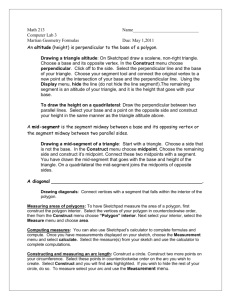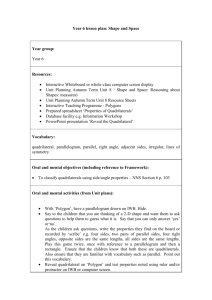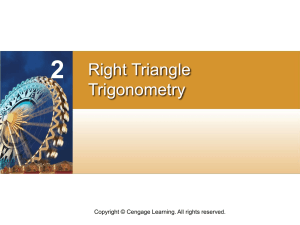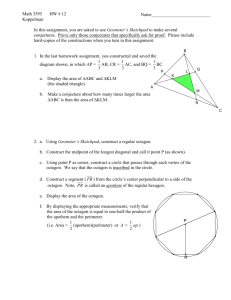Activity B1: Angle sums of triangles
advertisement
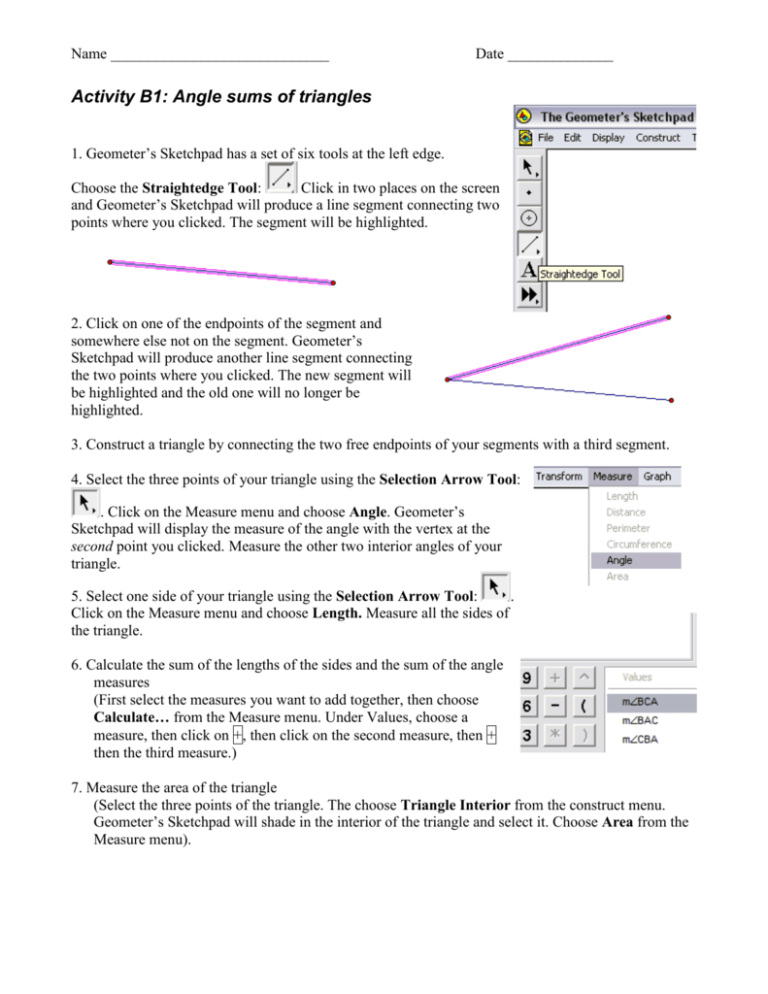
Name _____________________________ Date ______________ Activity B1: Angle sums of triangles 1. Geometer’s Sketchpad has a set of six tools at the left edge. Choose the Straightedge Tool: Click in two places on the screen and Geometer’s Sketchpad will produce a line segment connecting two points where you clicked. The segment will be highlighted. 2. Click on one of the endpoints of the segment and somewhere else not on the segment. Geometer’s Sketchpad will produce another line segment connecting the two points where you clicked. The new segment will be highlighted and the old one will no longer be highlighted. 3. Construct a triangle by connecting the two free endpoints of your segments with a third segment. 4. Select the three points of your triangle using the Selection Arrow Tool: . Click on the Measure menu and choose Angle. Geometer’s Sketchpad will display the measure of the angle with the vertex at the second point you clicked. Measure the other two interior angles of your triangle. 5. Select one side of your triangle using the Selection Arrow Tool: . Click on the Measure menu and choose Length. Measure all the sides of the triangle. 6. Calculate the sum of the lengths of the sides and the sum of the angle measures (First select the measures you want to add together, then choose Calculate… from the Measure menu. Under Values, choose a measure, then click on +, then click on the second measure, then + then the third measure.) 7. Measure the area of the triangle (Select the three points of the triangle. The choose Triangle Interior from the construct menu. Geometer’s Sketchpad will shade in the interior of the triangle and select it. Choose Area from the Measure menu). Name _____________________________ Date ______________ 8. Drag the vertices of the triangle around and observe how the measures change. a. When angle ABC is the largest angle, which side has the largest length? Does this always happen? b. Can you make a triangle in which one side is longer than the other two combined? 9. Create a second triangle and measure the same things. (Hint: to do this quickly choose Select All from the edit menu, then Copy, the Paste, then drag the new triangle and its measures to one side.) a. When two triangles have the same area, are their perimeters the same? b. When two triangles have the same perimeter, are their areas the same? c. When two triangles have the same area, are the sums of their angle measures the same? 10. List any special properties of triangles you have observed: Name _____________________________ Date ______________ Activity B2: Angle sums of quadrilaterals 1. Construct a quadrilateral (four segments joined at their endpoints). 2. Measure all the interior angles and sides of the quadrilateral (use Angle and Length under the Measure menu). 3. Calculate the sum of the lengths of the sides and the sum of the angle measures (Use Calculate…). 4. Measure the area of the quadrilateral (Construct the interior, then use Area under the Measure menu). 5. Drag the vertices of the quadrilateral around and observe how the measures change. a. When angle ABC is the largest angle, which side has the largest length? Does this always happen? b. Can you make a quadrilateral in which one side is longer than the other three combined? 6. Create a second quadrilateral and measure the same things. a. When two quadrilaterals have the same area, are their perimeters the same? b. When two quadrilaterals have the same perimeter, are their areas the same? c. When two quadrilaterals have the same area, are the sums of their angle measures the same? 7. List any special properties of quadrilaterals you have observed: 8. Construct one diagonal of the quadrilateral (Use the Segment tool to join two non-adjacent corners). Can you connect what you have observed about quadrilaterals to what you observed about triangles? Name _____________________________ Date ______________ Activity B3: Angle sums of polygons 1. Construct a polygon with five or more sides. 2. Measure all the interior angles and sides of the polygon. 3. Calculate the sum of the lengths of the sides and the sum of the angle measures. 4. Measure the area of the polygon. 5. Drag the vertices of the polygon around and observe how the measures change. 6. List any special properties of polygons you have observed: 7. How many diagonals does your polygon have? (Diagonals are segments joining points of the polygon, inside the polygon.) In general how many diagonals does a polygon with n sides have? 8. Can you connect what you have observed about polygons to what you observed about triangles and quadrilaterals?



